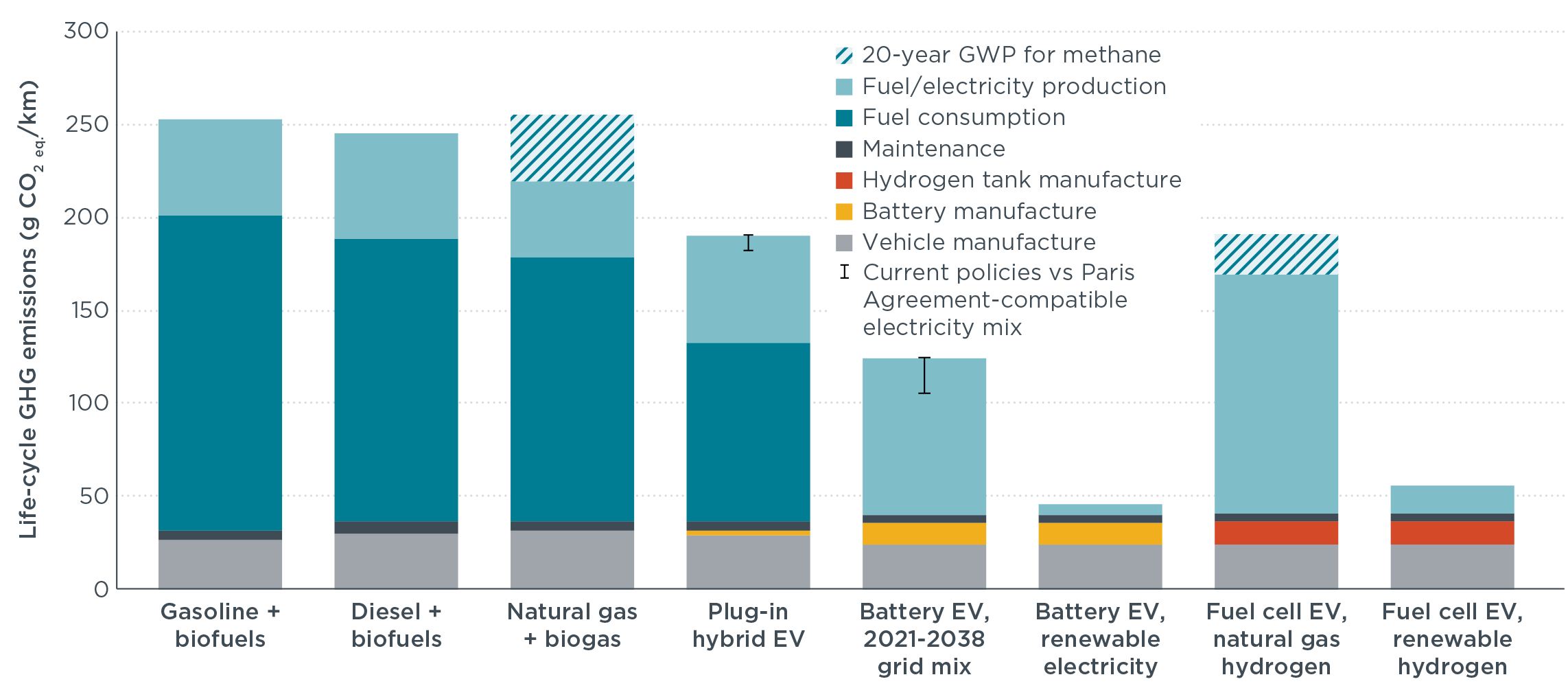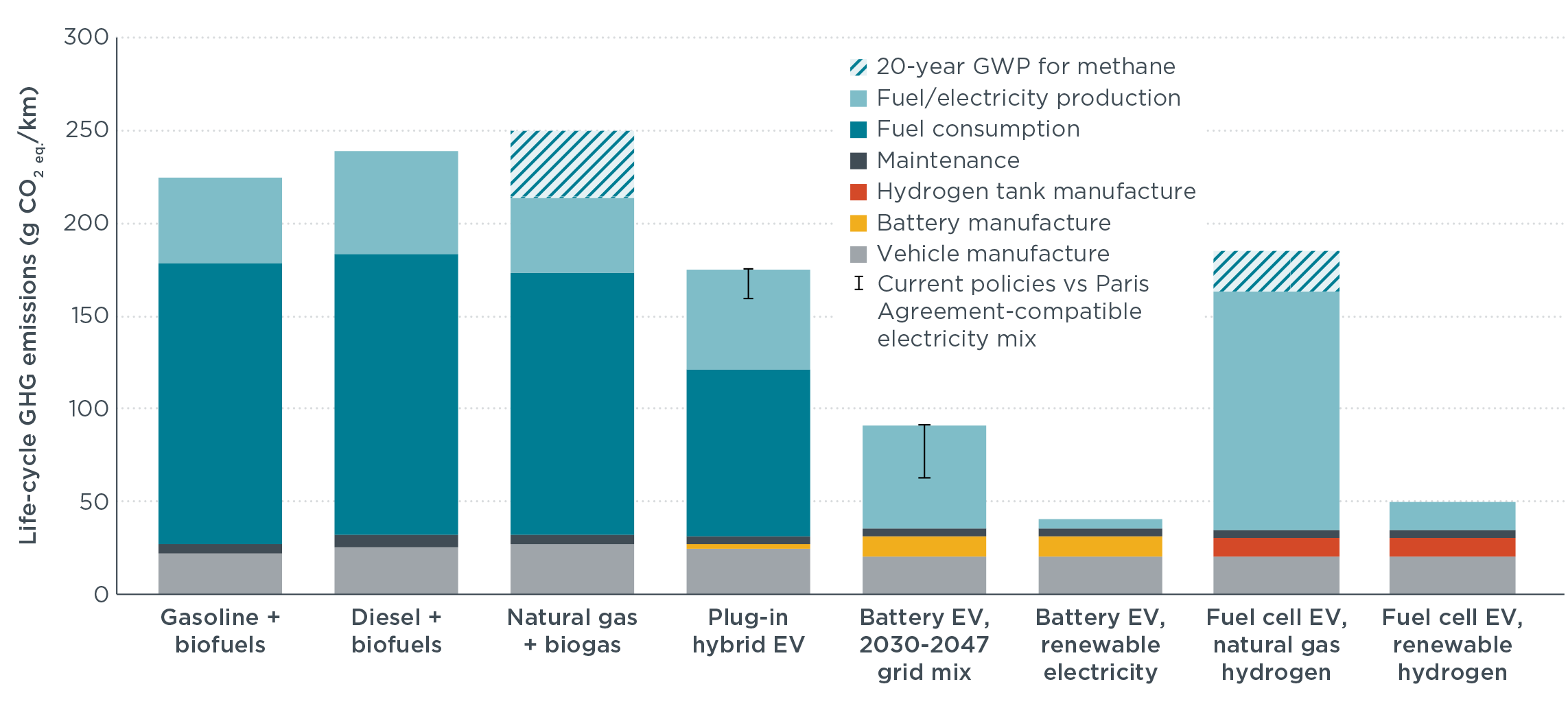Life-cycle greenhouse gas emissions of combustion engine and electric passenger cars in Europe
Blog
Why are electric vehicles the only way to quickly and substantially decarbonize transport?
If we want to reach Paris Agreement climate goals, we need deep decarbonization in all greenhouse gas (GHG) emitting sectors. Transport is near the top of the list because it’s one of the largest emitting sectors and one of the most challenging to decarbonize. Projections show the magnitude of GHG reductions needed in transport are about 40% from 2020 to 2030 and 80% from 2020 to 2050—and that’s just considering the emissions from the combustion and production of fuels and electricity. With the expected increase in transportation demand in the coming decades, emissions reductions per vehicle will need to be even larger.
Unfortunately, emissions from transport are still rising globally and there are not currently enough policies in place to get us anywhere near the targets. We need to ramp up ambition by orders of magnitude.
ICCT’s mission is to reduce and eventually eliminate the climate and health impacts of the transportation sector. We support policymaking and other measures that can accomplish that as quickly and cost-effectively as possible. The policy interventions we support are based on the results of rigorous technical analysis and we have no financial stake in which technologies “win.” We take no funding from regulated entities and no industry funding. This puts us in a position to bring forward impartial results.
We’ve just published a wide-ranging assessment of the life-cycle GHG emissions of various vehicle and fuel technology options for passenger cars in the United States, Europe (the European Union and the United Kingdom), China, and India. Across all four markets, the results are clear:
- Even for the cars registered today (see Figure 1, below), battery electric vehicles have by far the lowest life-cycle GHG emissions compared to all other technologies. Additionally, as electricity becomes lower carbon in the coming years, the life-cycle GHG emissions from these vehicles will decline further.
- Only battery electric and hydrogen fuel cell electric vehicles have the potential to be very-low GHG passenger vehicle pathways. There is no realistic path to deep decarbonization of internal combustion engine (ICE) vehicles within the time frame of the Paris targets.
- Current biofuels have relatively high GHG emissions and little growth potential due to limited feedstock.
- E-fuels offer near-zero carbon emissions, but cost parity with fossil fuels will likely only come by 2050 in the best case scenario.
- Hybrids and plug-in hybrids achieve modest near-term gains, but do not have long-term deep decarbonization potential.
Let me elaborate on these points.
Vehicle technologies in our analysis include ICEs (gasoline, diesel, and natural gas), hybrids, plug-in hybrids, battery electric, and fuel cell electric. Fuels in our analysis include gasoline/biofuel blends, diesel/biofuel blends, natural gas/biogas blends, electricity, and hydrogen. The carbon intensity of the various fuel blends we used were region-specific averages that were assumed to change over the next 30 years in line with current policy. For the changing electricity mix, we looked at two IEA scenarios – the Adopted Policy scenario and the Paris Agreement-aligned scenario. For hydrogen, we looked at the individual hydrogen sources separately. While natural gas based hydrogen reflects the current situation, 100% renewable electricity-based hydrogen shows the full emission reduction potential of that technology. We assumed a vehicle lifetime of 15–18 years, depending on the market, and that annual mileage decreases as vehicles age. Importantly, our assumptions of vehicle emissions/efficiency factors are based on real-world measurements and data collection. We included the GHG emissions from vehicle manufacture and recycling, battery manufacture, hydrogen tank manufacture, fuel/electricity production, fuel consumption, and vehicle maintenance.
As illustrated in Figure 1, for the (sales weighted) average medium-size car registered in China, Europe, India, and the United States in 2021, we found that gasoline and diesel ICE vehicle technologies fueled on a fossil/biofuel mix emit approximately 245–253 g CO2 eq./km over their lifetime. These figures already include today’s share of gasoline hybrids in the four regions. When looking at hybrids separately, the GHG emissions are approximately 20% lower, about 200 g CO2 eq./km. Natural gas cars are at about 219 g CO2 eq./km. When taking into account the high short term, 20-year global warming potential (GWP) of upstream methane emissions, however, the climate impact of natural gas cars is just as high as for gasoline or diesel cars. Plug-in hybrids partly fueled by fossil/biofuel and electricity are roughly 30% lower than gasoline cars, about 184–191 g CO2 eq./km. Fuel cell electrics fueled by natural gas based hydrogen are about 169 g CO2 eq./km. When taking into account the 20-year GWP of upstream methane emissions, they are at 191 g CO2 eq./km. Battery electrics fueled on average grid electricity are 105–124 g CO2 eq./km.
Figure 1. Life-cycle GHG emissions for global typical medium-size passenger cars registered in 2021.

These numbers illustrate global trends. Although numbers vary some from region to region, in all scenarios, battery electric vehicles are the lowest emitters, including for cars registered today. And the gap only grows as the grid decarbonizes. As shown in Figure 2, global typical battery electric vehicles projected to be registered in 2030 will only emit, on a life-cycle basis, 63–91 g CO2 eq./km. Once the grid is fully renewable, that number goes down to 41 g CO2 eq../km, and we see similar numbers for fuel cell vehicles fueled with renewable hydrogen.
Figure 2. Life-cycle GHG emissions for global typical medium-size passenger cars projected to be registered in 2030.

Why don’t biofuels have much impact in our analysis? The answer is that the vast majority of biofuels on the market today don’t offer much, if any, life-cycle GHG improvements over fossil gasoline or diesel. The supply of genuinely low GHG biofuel such as advanced waste- and residues-based biofuels is highly constrained, and in the best case scenario could only displace a small fraction of road fuel in the next decade. By 2050, we estimate the maximum amount of low-GHG bioenergy that will be available would be approximately 28 million barrels per day. This might sound like a lot, but demand from the aviation, marine, and plastics sectors will be around 31 million barrels per day, and that will leave nothing substantial for road transport.
And what about e-fuels? Many people are touting e-fuels as the perfect solution. When produced with renewable energy, it’s a nearly carbon neutral fuel that can be dropped into the existing fleet of ICEs to achieve something on par with the performance of electric vehicles from a life-cycle GHG perspective. The primary reason we don’t view e-fuels as a solution is cost. Even the most optimistic projections we are aware of estimate that e-fuel cost parity with fossil fuel would not come until 2050, and our analysis suggests this is a hyper-optimistic estimate and unrealistic. Also, 2050 is simply not workable considering the Paris Agreement timeline. Especially when considering that battery electric vehicle cost parity with ICEs is already here today on a total cost of ownership basis, and upfront cost parity is probably only about 5–8 years away. In addition, the energy efficiency of battery electric vehicles is 4–7 times higher than for e-fuels, so using renewable energy to fuel these vehicles goes a lot farther than using it to produce e-fuels.
As I said at the beginning, we need big, big reductions in the emissions from transport and all GHG emitting sectors. In the end, this impartial evaluation of the technology options for passenger cars reveals that battery electric vehicles are the technology with the lowest life-cycle GHG emissions, today and into the foreseeable future. The electric car transition cannot happen fast enough.
